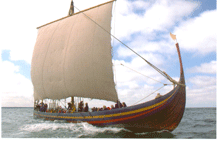Viking Story: Ireland and Denmark

Havhingsten, Dublin, Denmark, Vikings, Ireland’s National Museum
 During August 2007 the replica long ship “Havhingsten fra Glendalough” or Sea Stallion from Glendalough arrived in Dublin after a six week voyage from Denmark. With the help of huge cranes it was manoeuvred into position on the square at the centre of Collins Barrack, now part of Ireland’s National Museum. The vessel is on display to the public until next summer when it will be returned to the water and sailed back to Denmark.
During August 2007 the replica long ship “Havhingsten fra Glendalough” or Sea Stallion from Glendalough arrived in Dublin after a six week voyage from Denmark. With the help of huge cranes it was manoeuvred into position on the square at the centre of Collins Barrack, now part of Ireland’s National Museum. The vessel is on display to the public until next summer when it will be returned to the water and sailed back to Denmark.
This unique event received wide press and larger media coverage with interviews highlighting close ties between Ireland and Denmark. Of major cultural and historical significance it provides a contemporary link to the Viking Story into the twenty-first century. Legacy to a bygone age the names of Irish cities and other places derive from thriving Norse settlements while witness to their presence and life style continues through archaeological and historical finds.
Viking Story
Historical literature abounds about the Scandinavian pirates, warriors and traders who settled in many parts of North-West Europe in the late eighth to mid-eleventh centuries. From old Norse vikingr, from vik ‘creek’ or Old English wic ‘camp or dwelling place’, they established settlements in the British Isles (especially at York and Dublin) founding an Anglo-Danish dynasty. They also established settlements in Normandy, the East Baltic, Greenland and Vinland, the Viking name for the area of North-East America, probably Newfoundland. Viking literature and art are noted for their sagas and vitality.
Robert Lee’s Ireland: a history tells that suddenly, one day in AD 795, the Irish world experienced a new great shock. The first of thousands of long, beautifully-curving high-prowed boats filled with fierce and terrible strange warriors from beyond the sea beached on Lambay Island off the Dublin coast. It was the beginning of the Norsemen’s invasion of Ireland. Known as ‘Danes’ in Irish popular history, they came mainly from Norway. They came slaughtering, burning and ransacking their way into Irish history, terrorizing and looting Gaelic homestead and monastery alike.
More than a century later an Irish chronicler was still writing of ‘immense floods and countless sea-vomiting of ships and fleets so that there was not a harbour or land port in the whole of Munster without floods of Danes and pirates …’ Round towers, which can still be seen in many parts of Ireland, were built as combined belfries and refuges for the monasteries which Norsemen continually sacked … appalling scenes of brutality and terror must have been enacted …not once but many times in what are now such peaceful places.
A number of Viking settlements developed into the main towns of Ireland, including Dublin, Cork and Limerick. The place names Waterford, Wexford, Carlingford and Strangford all contain the Norse place-name fjord, while Arklow and Wicklow contain the element lo, meaning ‘meadow’. A number of Norse words, mainly connected with trade and seafaring, were borrowed into Irish, demonstrating their influence on the Irish in these matters.
The archaeological record shows that Irish goods ended up in Scandinavia where Irish artefacts are preserved in Nordic museums, the most sizeable collections in Norwegian museums, while the Vikings left hoards with coins, ingots, jewellery and other precious objects in Ireland, both of their own manufacture and brought from their raids elsewhere. Remains of their settlements, especially those in and around Dublin, have been extensively excavated. They include cemeteries at Islandbridge and Kilmainham, Dublin where furnished graves offer the clearest archaeological evidence for the presence of Vikings in Ireland.
The Vikings at first caused considerable damage to economic, cultural and religious life, but with their settlement they became involved in Irish political and economic affairs. Their leaders inter-married with Irish royalty and served as mercenaries in the Irish struggles for power.
Settling into the Gaelic pattern of warring kings, above all inter-marrying with the Gaelic Irish and becoming Irish themselves, the new Irish were to experience Ireland’s next great shock, when a small party of Normans, who had sailed across the sea from Wales, landed in Ireland on l May 1170. The invading Anglo-Normans turned the former Viking settlements into their main harbours and strongholds. The continuation of Ireland’s poignant and turbulent history tells another story.
Dublinia and the Viking World
Dublin’s major heritage attraction provides a living experience of the Viking Story with the arrival at Ireland’s shores of these pirates and fierce warriors. It brings to life the early settlements, enacts their occupation and life styles, trading and commercial practices, not least of which were the raids and ruthless plundering of tradable goods, livestock, provisions and people to sell as slaves.
Visitors can share a simulated sea voyage in a Viking vessel of the type of the replica long ship “Havhingsten fra Glendalough” presently on view in Dublin.
 Ita Marguet, September 2007
Ita Marguet, September 2007
Note: Acknowledgement is given to all sources of information used in the preparation of this article. It follows a text Ireland: A poignant and turbulent history (Ita Marguet, April 2004).


